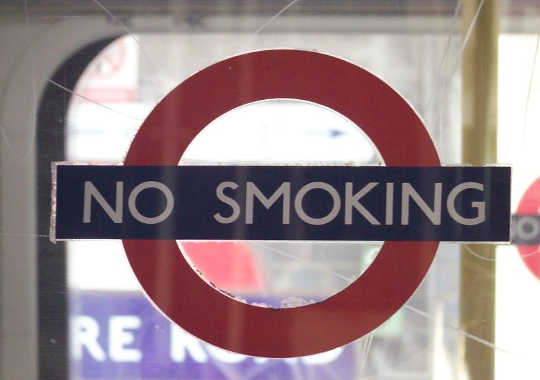
A no smoking sign in London. Via Flickr. kafka4prez/flickr, CC BY-SA
There is strong and consistent evidence that exposure to secondhand smoke causes heart attacks and that smokefree workplace and public place laws cut heart attacks (and other diseases). The most recent evidence comes from a large study in Sao Paolo, Brazil, where heart attack deaths dropped by 12 percent following implementation of its smokefree law. ![]()
Even so, we still hear people challenging the science. For example, a recent article by a onetime employee of the tobacco industry-supported Cato Institute and bartender, tries to use the natural variability in results in different studies to argue against this fact.
This is the latest echo of more direct attacks that the tobacco companies have mounted since the 1970s, when the evidence that secondhand smoke caused disease started accumulating. For decades as the evidence that secondhand smoke kills became stronger and more consistent, the media continued to quote people with tobacco industry ties, which made the science appear increasingly controversial rather than settled.
The cigarette companies themselves are now prohibited from challenging the established science by Judge Gladys Kessler’s landmark ruling in 2006 that the big cigarette companies defrauded the public violated the Racketeer and Corrupt Influenced Organizations Act (RICO) by sowing confusion about the dangers of smoking and secondhand smoke.
But that hasn’t stopped “third parties” from questioning the science.
Similar to the recently published 2017 article, in 2013 Forbes published an article by a financial and legal reporter entitled “Study Finds No Link Between Secondhand Smoke And Cancer.” The article ignored the fact that the US Surgeon General concluded secondhand smoke caused lung cancer in 1986 and that the U.S. Environmental Protection Agency concluded it was a “Class A” human carcinogen in 1991.
The actual study on secondhand smoke and lung cancer, however, found that women living in the same house with a smoker for 30 years or more had 60 percent higher odds of developing lung cancer. The certainty of this statement was only 95 percent! (Statisticians like to be more than 95 percent confident to call the effect “statistically significant”.) Like the attack on the heart attack studies, the Forbes piece ignored the larger body of evidence.
I have spent my professional life in tobacco control and have seen these tricks for decades, so understand why it is so important to pay attention to all the evidence.
The first evidence that smokefree laws cut heart attacks
Colleagues and I conducted a study in Helena, Montana, which showed a large - 40 percent - decline in heart attack admissions after Helena implemented a smokefree law in June 2002. The recent article attacked this finding, arguing that this drop is way too big to be real, and also pointed to an earlier preliminary analysis that found an even bigger drop - 60 percent.
These differences are less stark than they seem. The fact is that Helena is a small place in which there were not many heart attack hospital admissions, so there is relative large uncertainty in the estimate of the true drop in heart attack admissions caused by the smokefree law in the population in general. While our final published analysis documented a 40 percent drop in the six months we studied, this specific finding is consistent with a true effect of all smokefree laws on reducing heart attacks in the whole population of anywhere between one percent and 79 percent.
This range is what statisticians call the 95 percent confidence interval and journalists call “the margin of error.” The important point is that it does not include zero (i.e., no effect), so we can be 95 percent confident that the drop we observed was more than a chance finding.
More evidence accumulates
Since the Helena study, there have been many studies of changes in heart attack admissions following smokefree laws. They all found different changes, and some did not detect changes bigger than the margins of error associated with the individual studies, which was interpreted as no change. This is normal in any kind of scientific study; there is always natural variation.
That’s why it is important to consider all the evidence.
The U.S. Surgeon General did just that, in his 2014 report The Health Consequences of Smoking – 50 Years of Progress. The report, which goes through extensive vetting involving hundreds of scientists, looked at all the available data (35 studies of comprehensive smokefree laws, plus 14 studies of weaker laws) and concluded with a high level of confidence that there was a 15 percent drop in heart attack hospital admissions (with a margin of error of 12-18 percent).
But, isn’t 15 percent is a lot smaller than 40 percent? Yes. But the important point is that 15 percent is well within the 95 percent confidence interval we found in the original Helena study. What all this shows is that as we get more evidence, the estimates of the effect become more precise.
The population results are what you would expect based on the biology
The drop in heart attack hospital admissions is also what would be expected based on what we know about the biology of heart attacks. As the Surgeon General explained in her 2010 report, How Tobacco Smoke Causes Disease: The Biology and Behavioral Basis for Smoking-Attributable Disease, “Low levels of exposure, including exposures to secondhand tobacco smoke, lead to rapid and sharp increase in endothelial dysfunction and inflammation which are implicated in acute cardiovascular events and thrombosis.”
In plain English, secondhand smoke has immediate effects on blood and blood vessels in a way that increases the risk of triggering a heart attack.
And e-cigarettes have already been shown to have the same bad effects on blood vessels, heart rhythm, and other ways.
These effects are so big and fast that Colorado saw a 20 percent drop in ambulance calls when it enacted its state smokefree law (everywhere but casinos, which were exempted). Two years later, when the law was extended to casinos, ambulance calls dropped by 20 percent there too, catching up with the rest of the state.
That’s not all. Hospitalizations for asthma and other lung disease drop, too.
Like scientists, the media, the public, and public policymakers need to consider the big picture, not try to pick apart the studies one at a time. Every study has uncertainty. The real question is: Do the pieces fit together?
For secondhand smoke the answer is “yes.” Smokefree laws save lives, and they do it quickly.
About The Author
Stanton Glantz, Professor of Medicine, University of California, San Francisco
This article was originally published on The Conversation. Read the original article.
Related Books
at InnerSelf Market and Amazon























